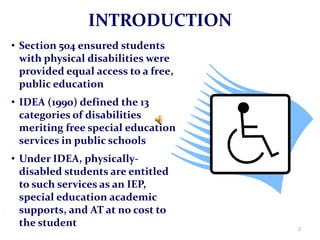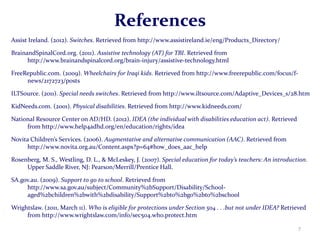Week 3 dq 2 fixed edu recommendations for at fern
- 1. Recommendations for Technology Supports for Learners with Physical Disabilities Fern Heffington EDU 352 August 24, 2012 Instructor David Sparks 1
- 2. INTRODUCTION • Section 504 ensured students with physical disabilities were provided equal access to a free, public education • IDEA (1990) defined the 13 categories of disabilities meriting free special education services in public schools • Under IDEA, physically- disabled students are entitled to such services as an IEP, special education academic supports, and AT at no cost to the student 2
- 3. PHYSICAL DISABILITIES • Impact mobility and use of limbs, and may experience sensorial, cognitive, motor, communication, or other neurological impairments • Encompass neurological, muscular, or other physical disorders resulting from serious injury, genetic disorders, or illness • Can severely impede academic, social, and behavioral functions • Focus of education is on social and practical life skills in the classroom and real-world environments 3 (Free, 2009)
- 4. Sip-and-Puff Assistive Technology (AT) • Disabilities impede full immersion in learning activities and social experiences • Potential for impact to academic skills and social and cultural identity • Sip-and-puff technology allows disabled learners to operate assistive (ILT, 2011) hardware by blowing into a straw apparatus • Allows for participation in academic and co-curricular activities with non- disabled students, increasing confidence and proficiency (Ireland, n.d.) 4
- 5. Augmentative and Alternative Communication (AAC) Devices • AAC devices allow students to communicate audibly through a keyboard and blow-pipe or joystick • Increases opportunities for social and academic communication • Allows students to express ideas and ask questions (ILT, 2011) • Increases confidence and proficiency through active participation and social inclusion (Ireland, 2012) 5
- 6. Summary and Conclusion • Disabled learners face a variety of physical, cognitive, social, emotional, and psychological issues • Impairments can significantly impact practical life skills, social and cultural identity and self-worth, and academic performance • Use of Sip-and-Puff and AAC technology increases the quality and breadth of academic and social experiences in the classroom (SA, 2009) 6
- 7. References Assist Ireland. (2012). Switches. Retrieved from http://www.assistireland.ie/eng/Products_Directory/ BrainandSpinalCord.org. (2011). Assistive technology (AT) for TBI. Retrieved from http://www.brainandspinalcord.org/brain-injury/assistive-technology.html FreeRepublic.com. (2009). Wheelchairs for Iraqi kids. Retrieved from http://www.freerepublic.com/focus/f- news/2172723/posts ILTSource. (2011). Special needs switches. Retrieved from http://www.iltsource.com/Adaptive_Devices_s/28.htm KidNeeds.com. (2001). Physical disabilities. Retrieved from http://www.kidneeds.com/ National Resource Center on AD/HD. (2012). IDEA (the individual with disabilities education act). Retrieved from http://www.help4adhd.org/en/education/rights/idea Novita Children’s Services. (2006). Augmentative and alternative communication (AAC). Retrieved from http://www.novita.org.au/Content.aspx?p=64#how_does_aac_help Rosenberg, M. S., Westling, D. L., & McLeskey, J. (2007). Special education for today’s teachers: An introduction. Upper Saddle River, NJ: Pearson/Merrill/Prentice Hall. SA.gov.au. (2009). Support to go to school. Retrieved from http://www.sa.gov.au/subject/Community%2bSupport/Disability/School- aged%2bchildren%2bwith%2bdisability/Support%2bto%2bgo%2bto%2bschool Wrightslaw. (2011, March 11). Who is eligible for protections under Section 504 . . .but not under IDEA? Retrieved from http://www.wrightslaw.com/info/sec504.who.protect.htm 7
Editor's Notes
- Under Section 504 of the Rehabilitation Act of 1973, students with physical disabilities were ensured equal access to a free, public education.The Individuals with Disabilities Education Act (IDEA) of 1990 established the 13 categories of disabilities meritingstudent access to free special educational services in the public school classroom, including autism, hearing and vision impairments, physical and learning disabilities, and mental and behavioral health issues. Under IDEA, the identified categories of disabilities were determined to adversely impact educational performance, necessitating special education in order to receive an appropriate education. Within the broader field of physical disabilities, the primary focus of the criterion is based upon significant impact to the learner’s progress due to frequent, terminal, or sustained health issues related to illness, injury, or other physical disability (AD/HD, 2012).Under the mandates of the IDEA, students are further provided an individualized education program (IEP) to identify the benchmarks and reporting for academic progress, special academicsupports, and assistive technology (AT) provided at no cost by the pubic school system. “If a child has a disability that adversely affects educational performance, that child is eligible for special education services under IDEA. All children who eligible for special education services under IDEA are protected under Section 504” (Wrightslaw, 2011, para. 7).
- Children who are defined as having physical disabilities present physical symptoms that impact mobility and use of their limbs. Physical disabilities encompass neurological, muscular, or other physical disorders and syndromes as a result of serious injury, genetic disorders, or illness. Dependent upon the advancement of the disability and the impacted parts of the body, physical disabilities may moderately or severely impede academic, social, and behavioral performance and functionality (Rosenberg, 2007). Students with physical disabilitiesmay also experience sensorial, cognitive, motor, communication, or other neurological impairments, impacting their ability to function effectively in the academic and social environments. The primary focus for education for children with physical disabilities is social functioning and practical life skills in the classroom and real-world environments (KidNeeds, 2001).
- Students with physical disabilities can present symptoms that affect motor skills and mobility, making it difficult to participate in the normal routines and activities in the classroom environment and co-curricular activities, particularly when students cannot actively use the same or similar tools as other students. This lack of active participation and practice can create gaps in academic proficiency and performance, social and cultural identity, and access to a wider breadth of information, activities, and learning experiences.For children with physical impairments that impact fine and gross motor skills, the use of tools that require some level of manual dexterity and operation is not feasible. With use of “sip-and-puff” technology, previously inaccessible and unusable objects become available for disabled learners. Sip-and-puff technology, which can be adapted to wheelchairs, digital communication devices, word processors, and computer hardware, allows disabled students to operate the associated piece of equipment through digital commands transmitted by inhaling and exhaling through a straw apparatus. Wheelchairs can also be controlled with use of a sip-and-puff control unit. Sip-and-puff control technology provides opportunities for disabled students to participate in a wider breath of academic and co-curricular activities, increasing exposure to appropriate individual and group interactions, behavioral norms, and differing perspectives and resources to augment the learning process. Increased mobility and accessibility through the sip-and-puff command system also increases confidence and proficiency functioning in the classroom (Brain, 2011).
- The AAC digital system, mounted to the arm of a wheelchair or portable with a small tripod for stationing on a table or desk, allows the student to communicate with use of commands entered on an accompanying keyboard. The key entry system may also be modified with use of a blow-pipe or joystick. The childselects the appropriate key entry or command, and the AAC digital system translates the data into audible words and phrases. The use of the AAC digital system increases opportunities for participation in students with physical disabilities that impact verbal communication with others and accurate expression of ideas and wants. The system can be effective as a tool to augment speech therapy for modeling of appropriate connotation, tone, and phonemic pronunciation. The AAC system allows students to accurately express ideas, ask questions, and actively participate in social interactions, increasing confidence and proficiency within the classroom environment and co-curricular activities (Novita, 2006).
- Students who are categorized as possessing physical disabilities face a variety of physical, cognitive, emotional, psychological, and social issues, dependent upon the severity of their physical impairments. These impairments can have significant impact on development of practical life skills, social and cultural identity and self-worth, and academic performance and progression, requiring mitigation from various special education support services, specialized therapies, and AT. With use of the Sip-and-Puff and AAC technological supports and special education resources, as mandated through IDEA, children with physical disabilities in public schools have obtained increased the quality and access to the full breadth of academic, social, and co-curricular activities within the classroom and school environment.
- Assist Ireland. (2012). Switches. Retrieved from http://www.assistireland.ie/eng/Products_Directory/BrainandSpinalCord.org. (2011). Assistive technology (AT) for TBI. Retrieved from http://www.brainandspinalcord.org/brain-injury/assistive-technology.htmlFreeRepublic.com. (2009). Wheelchairs for Iraqi kids. Retrieved from http://www.freerepublic.com/focus/f-news/2172723/postsILTSource. (2011). Special needs switches. Retrieved from http://www.iltsource.com/Adaptive_Devices_s/28.htmKidNeeds.com. (2001). Physical disabilities. Retrieved from http://www.kidneeds.com/National Resource Center on AD/HD. (2012). IDEA (the individual with disabilities education act). Retrieved from http://www.help4adhd.org/en/education/rights/ideaNovita Children’s Services. (2006). Augmentative and alternative communication (AAC). Retrieved from http://www.novita.org.au/Content.aspx?p=64#how_does_aac_helpRosenberg, M. S., Westling, D. L., & McLeskey, J. (2007). Special education for today’s teachers: An introduction. Upper Saddle River, NJ: Pearson/Merrill/Prentice Hall.SA.gov.au. (2009). Support to go to school. Retrieved from http://www.sa.gov.au/subject/Community%2bSupport/Disability/School-aged%2bchildren%2bwith%2bdisability/Support%2bto%2bgo%2bto%2bschoolWrightslaw. (2011, March 11). Who is eligible for protections under Section 504 . . .but not under IDEA? Retrieved from http://www.wrightslaw.com/info/sec504.who.protect.htm






